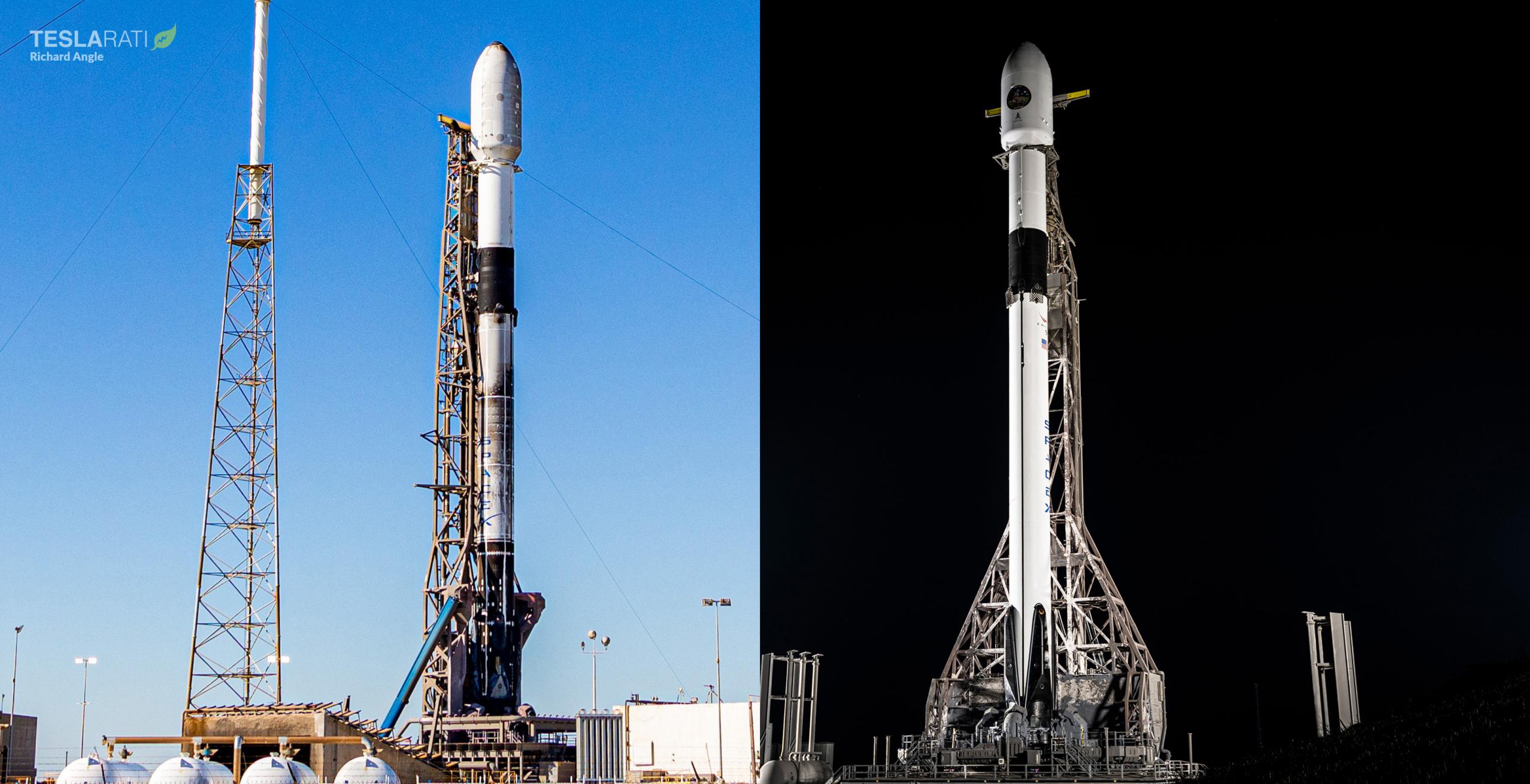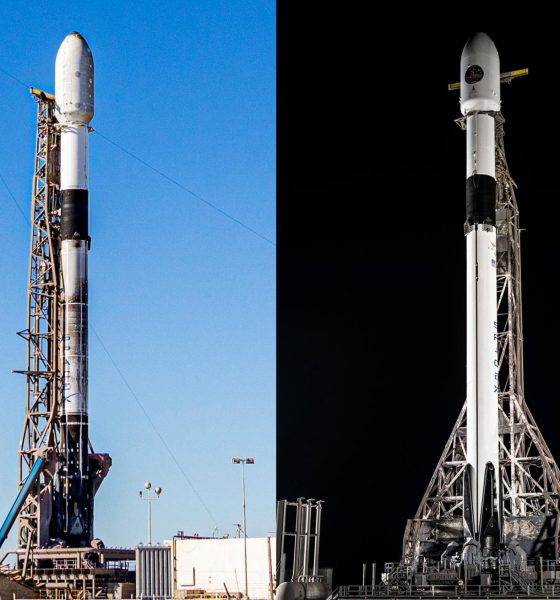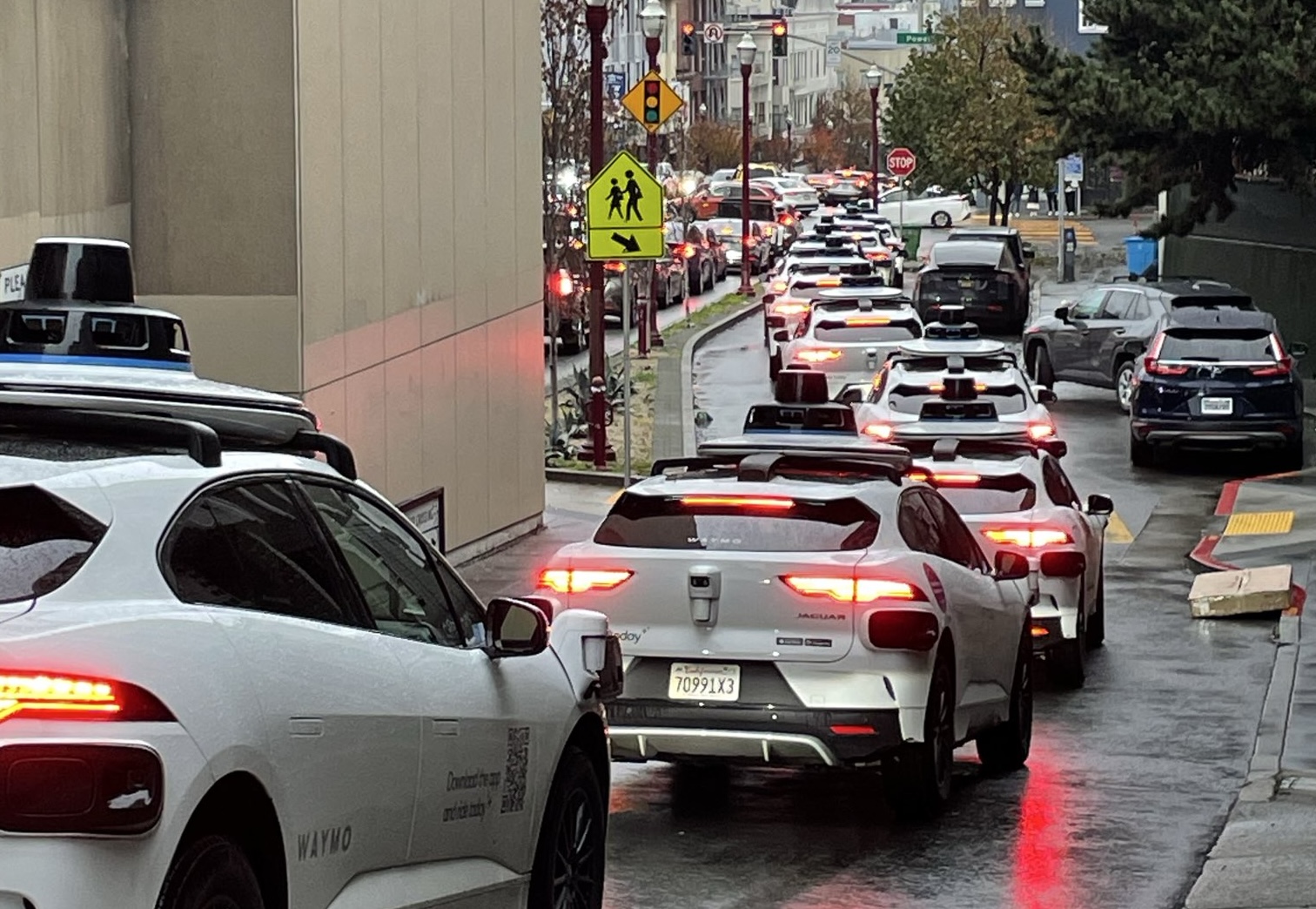

News
SpaceX preparing for back-to-back Starlink launches from California and Florida
Update: Next Spaceflight reports that SpaceX has delayed Starlink 4-15 to 4:38 pm EDT, May 14th, ending the immediate possibility of a new SpaceX record for time between launches.
After a few days of delays pushed the missions closer together, SpaceX is now preparing to launch two batches of 53 Starlink satellites just eight hours apart – one from Florida and the other from California.
Originally scheduled to launch as early May 10th, which would have tied SpaceX’s Vandenberg Space Force Base (VSFB) SLC-4E launch pad turnaround record, Starlink 4-13 slipped to May 12th within the last few days. 2400 miles (~3900 km) to the east, SpaceX’s Starlink 4-15 mission – preparing to launch from the company’s Cape Canaveral Space Force Station (CCSFS) LC-40 pad – recently found itself in the opposite boat.
On April 22nd, Spaceflight Now reported that Starlink 4-15 was scheduled to launch no earlier than (NET) May 8th. At the time, Starlink 4-13 was also scheduled to launch on the 8th, placing the two Starlink missions just a few hours apart. On April 28th, Spaceflight Now updated its well-sourced launch calendar, revealing that Starlink 4-13 had slipped to May 10th and Starlink 4-15 to May 16th, ending their concurrence. Finally, on May 7th and May 8th, photographer Ben Cooper reported that Starlink 4-15 had moved up to 2:08 am EDT (06:08 UTC), May 13th and FAA documents revealed that Starlink 4-13 had slipped again to 3:29 pm PDT (22:29 UTC), May 12th.
In other words, the missions have again found themselves just a handful of hours apart after weeks of unrelated juggling and delays. Barring additional issues, Starlink 4-13 and Starlink 4-15 are scheduled to launch just 7 hours and 41 minutes apart. Set in late 2021, the shortest time between two Falcon launches is currently 15 hours and 17 minutes. But above all else, the constant back and forth – only to end up with both launches again just hours apart – demonstrates just how agonizing and unforgiving the planning behind every rocket launch schedule truly is.
Fittingly, Starlink 4-13’s drone ship headed to sea just ~60 hours before the scheduled launch and Starlink 4-15’s drone ship has yet to depart, keeping the launch dates of both missions about as uncertain as they can be without guaranteeing that delays are coming. Both drone ships must be towed about 400 miles downrange at speeds that almost never exceed 8-10 mph, translating to a minimum two-day journey even with zero stops, slowdowns, or detours.
Beyond the record-breaking potential, Starlink 4-13 is an otherwise ordinary mission that will launch another 53 Starlink V1.5 satellites to an ordinary 53.2-degree inclination, which simply means that they’ll end up in the same ‘shell’ as the other satellites in Starlink’s ‘Group 4’ shell. Despite launching from the opposite coast of the US, Starlink 4-15 will be almost identical and is expected to deploy another 53 Starlink V1.5 satellites to the same orbital shell. However, it appears that Starlink 4-15 will have a few highly unusual features.
Instead of performing a hockey stick-like ‘dogleg’ maneuver to avoid overflying any populated islands in the Bahamas, Falcon 9 will directly overfly the country’s largest western island and attempt to land right in the middle of the archipelago, potentially touching down on a drone ship just 5-15 miles away from Nassau and a couple other islands. The fact alone that SpaceX was able to convince both the Bahamas and the US’ FAA to allow it to fly the trajectory shown above is extremely impressive and belies a deep trust in SpaceX’s expertise and Falcon 9’s safety and reliability. At the same time, SpaceX may be taking some degree of risk, as the trajectory’s minuscule margins for error probably mean that Falcon 9’s automatic flight termination system will be programmed to destroy the rocket at the slightest hint of deviation from the planned trajectory.
Adding to the oddity, Starlink 4-15 will be the first in a long line of 45 dedicated Starlink launches to debut a new Falcon 9 booster. According to Next Spaceflight, Falcon 9 B1073 will claim that unusual first, almost entirely flipping the table on the precedent of conservative government customers – still timid about SpaceX reusability – scrambling to secure increasingly rare launch opportunities on new Falcon 9 boosters. Alternatively, it’s possible – but unlikely – that SpaceX implemented significant changes to Falcon 9 B1073 that it wants to verify independently before risking customer payloads.
With any luck, the new rocket will perform flawlessly and give some nearby Bahamians a truly one-of-a-kind experience: the ability to watch a SpaceX Falcon 9 booster land at sea… from the comfort of their own homes.

News
Waymo scrutinized after self-driving taxis cause traffic jams during SF blackout
It’s not farfetched to speculate that it would have been a doomsday scenario for Tesla had FSD behaved this way.

A power outage across San Francisco over the weekend forced numerous Waymo self-driving taxis to stop at darkened intersections and cause traffic blockages in multiple locations across the city. The disruption left riders stranded, frustrated drivers blocked, and city officials stepping in as the Alphabet-owned company temporarily suspended service amid the widespread gridlock.
Needless to say, it would likely have been a doomsday scenario for Tesla had FSD behaved in a similar way, especially if fleets of its robotaxis blocked traffic for numerous drivers.
Power outage halts Waymo fleet
The outage knocked out electricity for tens of thousands of customers, leaving traffic signals dark across large parts of the city, as noted in a report from the New York Times. Waymo vehicles began stopping at intersections and remained stationary for extended periods, seemingly unable to operate. Tow truck operators worked through the night removing immobilized vehicles, while videos circulated online showing Waymos with hazard lights flashing as traffic backed up around them.
Waymo later confirmed that it had paused its Bay Area ride-hailing service after the San Francisco mayor’s office contacted the company about the congestion its vehicles were contributing to. Service began coming back online shortly after 3:30 p.m. local time, though some users still reported being unable to request rides. Waymo maintained that no injuries or accidents were reported during the outage.
Autonomous cars during emergencies
The incident surprised industry observers since autonomous vehicles are designed to function during signal outages and temporary connectivity losses. Waymo stated that its vehicles treat nonfunctional signals as four-way stops, but “the sheer scale of the outage led to instances where vehicles remained stationary longer than usual to confirm the state of the affected intersections. This contributed to traffic friction during the height of the congestion.” Experts suggested the problem may have been linked to the vehicles’ reliance on remote assistance teams, which help resolve complex situations the cars cannot handle independently.
“Yesterday’s power outage was a widespread event that caused gridlock across San Francisco, with non-functioning traffic signals and transit disruptions. While the failure of the utility infrastructure was significant, we are committed to ensuring our technology adjusts to traffic flow during such events,” the Waymo spokesperson stated, adding that it is “focused on rapidly integrating the lessons learned from this event, and are committed to earning and maintaining the trust of the communities we serve every day.”
News
Tesla aims to combat common Full Self-Driving problem with new patent
Tesla writes in the patent that its autonomous and semi-autonomous vehicles are heavily reliant on camera systems to navigate and interact with their environment.

Tesla is aiming to combat a common Full Self-Driving problem with a new patent.
One issue with Tesla’s vision-based approach is that sunlight glare can become a troublesome element of everyday travel. Full Self-Driving is certainly an amazing technology, but there are still things Tesla is aiming to figure out with its development.
Unfortunately, it is extremely difficult to get around this issue, and even humans need ways to combat it when they’re driving, as we commonly use sunglasses or sun visors to give us better visibility.
Cameras obviously do not have these ways to fight sunglare, but a new patent Tesla recently had published aims to fight this through a “glare shield.”
Tesla writes in the patent that its autonomous and semi-autonomous vehicles are heavily reliant on camera systems to navigate and interact with their environment.

The ability to see surroundings is crucial for accurate performance, and glare is one element of interference that has yet to be confronted.
Tesla described the patent, which will utilize “a textured surface composed of an array of micro-cones, or cone-shaped formations, which serve to scatter incident light in various directions, thereby reducing glare and improving camera vision.”

The patent was first spotted by Not a Tesla App.
The design of the micro-cones is the first element of the puzzle to fight the excess glare. The patent says they are “optimized in size, angle, and orientation to minimize Total Hemispherical Reflectance (THR) and reflection penalty, enhancing the camera’s ability to accurately interpret visual data.”
Additionally, there is an electromechanical system for dynamic orientation adjustment, which will allow the micro-cones to move based on the angle of external light sources.
This is not the only thing Tesla is mulling to resolve issues with sunlight glare, as it has also worked on two other ways to combat the problem. One thing the company has discussed is a direct photon count.
CEO Elon Musk said during the Q2 Earnings Call:
“We use an approach which is direct photon count. When you see a processed image, so the image that goes from the sort of photon counter — the silicon photon counter — that then goes through a digital signal processor or image signal processor, that’s normally what happens. And then the image that you see looks all washed out, because if you point the camera at the sun, the post-processing of the photon counting washes things out.”
Future Hardware iterations, like Hardware 5 and Hardware 6, could also integrate better solutions for the sunglare issue, such as neutral density filters or heated lenses, aiming to solve glare more effectively.
Elon Musk
Delaware Supreme Court reinstates Elon Musk’s 2018 Tesla CEO pay package
The unanimous decision criticized the prior total rescission as “improper and inequitable,” arguing that it left Musk uncompensated for six years of transformative leadership at Tesla.

The Delaware Supreme Court has overturned a lower court ruling, reinstating Elon Musk’s 2018 compensation package originally valued at $56 billion but now worth approximately $139 billion due to Tesla’s soaring stock price.
The unanimous decision criticized the prior total rescission as “improper and inequitable,” arguing that it left Musk uncompensated for six years of transformative leadership at Tesla. Musk quickly celebrated the outcome on X, stating that he felt “vindicated.” He also shared his gratitude to TSLA shareholders.
Delaware Supreme Court makes a decision
In a 49-page ruling Friday, the Delaware Supreme Court reversed Chancellor Kathaleen McCormick’s 2024 decision that voided the 2018 package over alleged board conflicts and inadequate shareholder disclosures. The high court acknowledged varying views on liability but agreed rescission was excessive, stating it “leaves Musk uncompensated for his time and efforts over a period of six years.”
The 2018 plan granted Musk options on about 304 million shares upon hitting aggressive milestones, all of which were achieved ahead of time. Shareholders overwhelmingly approved it initially in 2018 and ratified it once again in 2024 after the Delaware lower court struck it down. The case against Musk’s 2018 pay package was filed by plaintiff Richard Tornetta, who held just nine shares when the compensation plan was approved.
A hard-fought victory
As noted in a Reuters report, Tesla’s win avoids a potential $26 billion earnings hit from replacing the award at current prices. Tesla, now Texas-incorporated, had hedged with interim plans, including a November 2025 shareholder-approved package potentially worth $878 billion tied to Robotaxi and Optimus goals and other extremely aggressive operational milestones.
The saga surrounding Elon Musk’s 2018 pay package ultimately damaged Delaware’s corporate appeal, prompting a number of high-profile firms, such as Dropbox, Roblox, Trade Desk, and Coinbase, to follow Tesla’s exodus out of the state. What added more fuel to the issue was the fact that Tornetta’s legal team, following the lower court’s 2024 decision, demanded a fee request of more than $5.1 billion worth of TSLA stock, which was equal to an hourly rate of over $200,000.
Delaware Supreme Court Elon Musk 2018 Pay Package by Simon Alvarez








